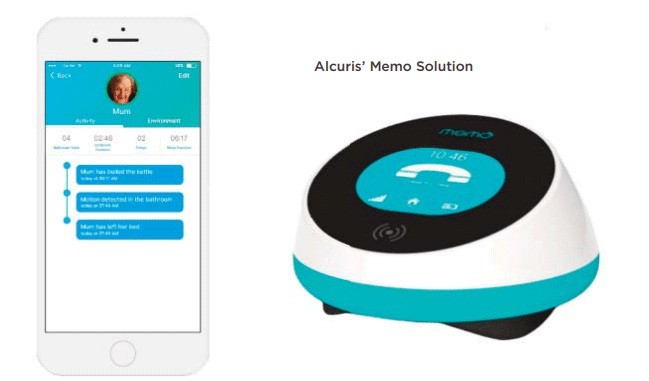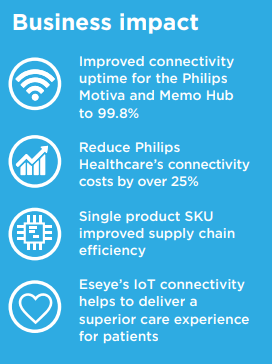The demand for telehealth and telecare technology has skyrocketed in 2020, primarily fuelled by COVID-19 and the need to provide remote health monitoring to safeguard the vulnerable. A recent study forecasts a sevenfold growth in telehealth by 20251. The global pandemic has disrupted the healthcare industry and accelerated it towards a new era of smart health. Patient behaviour has shifted: a new survey in the US found that two-thirds are now willing to try virtual care because of the ongoing health crisis2.
Telehealth encompasses a wide range of technologies, including remote patient monitoring (RPM) and enables healthcare to be delivered outside of the traditional healthcare setting – affording greater flexibility and reduced disease transmission risks. But for telehealth to work at optimum efficiency, it needs to be highly accurate and able to relay vital signs data in realtime. Telehealth devices demand exceptional IoT connectivity – the risk of latency comes at a high price, negatively impacting on patient outcomes
Transforming home patient care for Philips Healthcare and Alcuris
Philips Motiva is an interactive telehealth platform expertly designed by Philips Healthcare to empower patients to manage their chronic conditions, such as Chronic Heart Failure, Diabetes Mellitus, and Chronic Obstructive Pulmonary Disease (COPD). With data sent directly to their healthcare provider, medical staff can deliver effective patient care based on vital sign measurements. The intuitive system tailors to suit individual requirements and monitors weight, blood pressure and oxygen saturation in the blood.
Philips Healthcare needed a fully managed connectivity solution, which would grant reliable, in-home connectivity to the Philips Motiva product and enable ubiquitous connectivity across Europe. Philips Healthcare previously held contracts with multiple European network operators and purchased SIM and connectivity services at regional or individual country level.
This fragmented approach to connectivity impacted the manufacturing, logistics and operational processes, as no single SIM solution or connectivity service was available in Philips Healthcare’s primary markets. In addition to the inefficiencies in the procurement and manufacturing processes, the solution often required multiple engineering visits. This delayed the installation process and expended significant time and money.
Furthermore, despite utilising connectivity from many different network operators, Philips was unable to achieve the critically high levels of uptime that Motiva required. All of which led to a sub-standard solution that was putting patients at risk and negatively impacting the care experience.
Alcuris is the award-winning assistive remote patient monitoring RPM technology start-up behind the Memo platform; an advanced home monitoring service to support older or vulnerable individuals. Memo was created to enable better-connected care between patients and caregivers and help to fill a gap in the social care system. Working closely with local councils in the UK, Alcuris’ mission is to prolong the independence of vulnerable and older individuals, offer reassurance to caregivers, and provide actionable care insights.

The Memo platform is a connected family of products formed of a telecare hub, mobile app, real-time data dashboard and a range of sensors including door, motion and fall detectors which link with the Memo Hub.
IoT lies at the heart of the Memo solution. To maximise the full benefits of this telecare platform, Alcuris sought a cellular connectivity specialist who could ensure maximum connectivity uptime and the safe provision of data transfer to the Alcuris database. Obtaining real-time, accurate data and insights is crucial as it could be the difference between life and death.
Multi-network IoT connectivity without limits
Much like the premise behind the Motiva and Memo, the AnyNet+ SIM and cellular connectivity service from Eseye is all about flexibility and freedom. Eseye’s eUICC compliant, multi-network SIM technology allows devices to localise connectivity by rotating between multiple mobile network operator profiles. These networks can switch dynamically and autonomously at the SIM level with a choice of networks (IMSIs). And additional networks can be loaded over-the-air using the AnyNet Connectivity Management Platform which futureproofs any deployment.
The AnyNet+ SIM helps both organisations to achieve reliable cellular connectivity around the world while avoiding permanent roaming restrictions. Each Motiva and Memo Hub device work from any location – without limits.
Eseye’s unique multi-network switching capability safeguards against poor connectivity: an imperative requirement for Alcuris which must maintain a highly reliable, resilient and critical connection between the Memo Hub and a 24/7 alarm monitoring centre.
Healthcare data gathered is securely transmitted back to Philips’ and Alcuris’ via a secure VPN, maintaining the integrity of sensitive patient health data between home and hospital.
“Previously we had not considered a roaming solution due to fixed data plans and high over-usage charges. Using Eseye’s AnyNet+ SIM broke down these barriers and gave us one price, one contract and a single invoice for all global connectivity.” – Udo Goldbach, operations manager Europe, Philips Healthcare

Telehealth and telecare are transforming value-based care and creating digitally empowered patients; patients who are encouraged to lead their lives independently and take control of their chronic conditions.
Bringing IoT powered smart healthcare into the home increases patient’s flexible access to essential care and improves health outcomes, all while alleviating the strain on primary, hospital and community care.
IoT connectivity is a critical enabler for telehealth and telecare: propelling healthcare to shift its approach from reactive to proactive prevention.
About Eseye: Eseye empowers businesses to embrace IoT without limits. We deliver innovative IoT cellular connectivity solutions that help our customers drive up business value, deploy differentiated experiences and disrupt their markets. Supported by a powerful partner ecosystem, we seamlessly connect devices across 190 countries, agnostic to over 700 available global networks. Now it’s your time to disrupt: www.eseye.com/NoLimits
1. Frost & Sullivan Study, May 2020, https://go.frost.com/NA_PR_TH_MFernandez_K488_Telehealth_May20
2. Sykes Survey, https://www.healthcareitnews.com/news/survey-americans-perceptions-telehealth-covid-19-era










